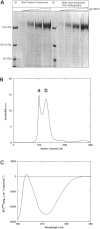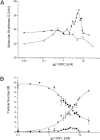Dynamics of the gp130 cytokine complex: a model for assembly on the cellular membrane
- PMID: 15722452
- PMCID: PMC2279283
- DOI: 10.1110/ps.041117105
Dynamics of the gp130 cytokine complex: a model for assembly on the cellular membrane
Abstract
Cytokines of the interleukin-6 (IL-6)-type family all bind to the glycoprotein gp130 on the cell surface and require interaction with two gp130 or one gp130 and another related signal transducing receptor subunit. In addition, some cytokines of this family, such as IL-6, interleukin-11, ciliary neurotrophic factor, neuropoietin, cardiotrophin-1, and cardiotrophin-1-like-cytokine, interact with specific ligand binding receptor proteins. High- and low-affinity binding sites have been determined for these cytokines. So far, however, the stoichiometry of the signaling receptor complexes has remained unclear, because the formation of the cytokine/cytokine-receptor complexes has been analyzed with soluble receptor components in solution, which do not necessarily reflect the situation on the cellular membrane. Consequently, the binding affinities measured in solution have been orders of magnitude below the values obtained with whole cells. We have expressed two gp130 extracellular domains in the context of a Fc-fusion protein, which fixes the receptors within one dimension and thereby restricts the flexibility of the proteins in a fashion similar to that within the plasma membrane. We measured binding of IL-6 and interleukin-b receptor (IL-6R) by means of fluorescence-correlation spectroscopy. For the first time we have succeeded in recapitulating in a cell-free condition the binding affinities and dynamics of IL-6 and IL-6R to the gp130 receptor proteins, which have been determined on whole cells. Our results demonstrate that a dimer of gp130 first binds one IL-6/IL-6R complex and only at higher ligand concentrations does it bind a second IL-6/IL-6R complex. This view contrasts with the current perception of IL-6 receptor activation and reveals an alternative receptor activation mechanism.
Figures





Similar articles
-
Activation of the signal transducer glycoprotein 130 by both IL-6 and IL-11 requires two distinct binding epitopes.J Immunol. 1999 Feb 1;162(3):1480-7. J Immunol. 1999. PMID: 9973404
-
The N-terminus of gp130 is critical for the formation of the high-affinity interleukin-6 receptor complex.Growth Factors. 1999;16(4):265-78. doi: 10.3109/08977199909069145. Growth Factors. 1999. PMID: 10427501
-
Specific inhibition of IL-6 signalling with monoclonal antibodies against the gp130 receptor.Cytokine. 1997 Apr;9(4):233-41. doi: 10.1006/cyto.1996.0159. Cytokine. 1997. PMID: 9112331
-
Gp130 and the interleukin-6 family of cytokines.Annu Rev Immunol. 1997;15:797-819. doi: 10.1146/annurev.immunol.15.1.797. Annu Rev Immunol. 1997. PMID: 9143707 Review.
-
IL-6 transsignaling: the in vivo consequences.J Interferon Cytokine Res. 2005 May;25(5):241-53. doi: 10.1089/jir.2005.25.241. J Interferon Cytokine Res. 2005. PMID: 15871661 Review.
Cited by
-
Inhibition of protein kinase II (CK2) prevents induced signal transducer and activator of transcription (STAT) 1/3 and constitutive STAT3 activation.Oncotarget. 2014 Apr 30;5(8):2131-48. doi: 10.18632/oncotarget.1852. Oncotarget. 2014. PMID: 24742922 Free PMC article.
-
Cleavage Site Localization Differentially Controls Interleukin-6 Receptor Proteolysis by ADAM10 and ADAM17.Sci Rep. 2016 May 6;6:25550. doi: 10.1038/srep25550. Sci Rep. 2016. PMID: 27151651 Free PMC article.
-
An interleukin-6 receptor-dependent molecular switch mediates signal transduction of the IL-27 cytokine subunit p28 (IL-30) via a gp130 protein receptor homodimer.J Biol Chem. 2013 Feb 8;288(6):4346-54. doi: 10.1074/jbc.M112.432955. Epub 2012 Dec 3. J Biol Chem. 2013. PMID: 23209286 Free PMC article.
-
Interleukin-6 and its receptor: from bench to bedside.Med Microbiol Immunol. 2006 Dec;195(4):173-83. doi: 10.1007/s00430-006-0019-9. Epub 2006 May 31. Med Microbiol Immunol. 2006. PMID: 16741736 Review.
-
Characterization of the Cancer-Associated Meprin Βeta Variants G45R and G89R.Front Mol Biosci. 2021 Oct 6;8:702341. doi: 10.3389/fmolb.2021.702341. eCollection 2021. Front Mol Biosci. 2021. PMID: 34692768 Free PMC article.
References
-
- Auguste, P., Guillet, C., Fourcin, M., Olivier, C., Veziers, J., Pouplard Barthelaix, A., and Gascan, H. 1997. Signaling of type II oncostatin M receptor. J. Biol. Chem. 272 15760–15764. - PubMed
-
- Boulanger, M.J., Bankovich, A.J., Kortemme, T., Baker, D., and Garcia, K.C. 2003a. Convergent mechanisms for recognition of divergent cytokines by the shared signaling receptor gp130. Mol. Cell 12 577–589. - PubMed
-
- Boulanger, M.J., Chow, D.-C., Brevnova, E.E., and Garcia, K.C. 2003b. Hexameric structure and assembly of the interleukin-6/IL-6 a receptor/gp130 complex. Science 300 2101–2104. - PubMed
-
- Chen, G.C. and Yang, J.T. 1977. Two-point calibration of circular dichrometer with d-10-camphorsulfonic acid. Anal. Lett. 10 1195–1207.
-
- Chow, D.-C., He, X.-L., Snow, A.L., Rose-John, S., and Garcia, K.C. 2001. Structure of an extracellular gp130-cytokine receptor signalling complex. Science 291 2150–2155. - PubMed
Publication types
MeSH terms
Substances
LinkOut - more resources
Full Text Sources
Research Materials

